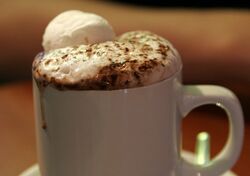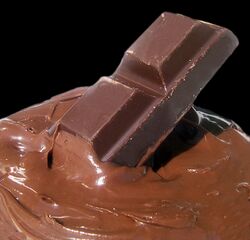Biology:Outline of chocolate
From HandWiki
Short description: Overview and topical guide to chocolate
The following outline is provided as an overview of and topical guide to chocolate:
What is chocolate?
- Chocolate – raw or processed food produced from the seed of the tropical Theobroma cacao tree.[1] The seeds of the cacao tree have an intense bitter taste, and must be fermented to improve the flavour. Chocolate is a popular ingredient in confectionery items and candies.
What type of thing is chocolate?
Chocolate is a type of:
- Food – substance to provide nutritional support for the body, ingested by an organism and assimilated by the organism's cells in an effort to produce energy, maintain life, and/or stimulate growth.
- Confectionery – the set of food items that are rich in sugar, any one or type of which is called a confection. Modern usage may include substances rich in artificial sweeteners as well.
- Candy – confection made from a concentrated solution of sugar in water, to which flavourings and colourants are added. Candies come in numerous colours and varieties and have a long history in popular culture.
- Ingredient – substance that forms part of a mixture (in a general sense). For example, in cooking, recipes specify which ingredients are used to prepare a specific dish. Chocolate is often used as an ingredient in dessert items, such as cakes and cookies.
- Confectionery – the set of food items that are rich in sugar, any one or type of which is called a confection. Modern usage may include substances rich in artificial sweeteners as well.
What is chocolate made of?
Necessary ingredients
- Chemistry:Cocoa butter – Pale-yellow, edible fat extracted from the cocoa bean
Substances found in cacao
- Antioxidants – Compound that inhibits the oxidation of other molecules
- Chemistry:Catechin – Type of natural phenol, antioxidant, and a plant secondary metabolite
- Chemistry:Flavonols – Class of plant and fungus secondary metabolites
- Biology:Caffeine – Central nervous system stimulant
- Phenethylamine – psychoactive drug that is usually inactive when orally ingested because most of it is metabolized into phenylacetic acid by monoamine oxidase (MAO), preventing significant concentrations from reaching the brain[2][3]
- Theobromine – also known as xantheose,[4] it contains no bromine[5] and has a similar, but lesser, effect to caffeine
- Theophylline – methylxanthine drug found in tea leaves
Source of the cocoa bean
- Biology:Theobroma cacao, also known as Cacao tree – Species of tree grown for its cocoa beans
- Forastero – 80% made with this tree group
Optional ingredients
- Chemistry:Caramel – Confectionery product made by heating sugars
- Biology:Lecithin – Generic term for amphiphilic substances of plant and animal origin
- Peanuts – Legume cultivated as a grain and oil crop
- Chemistry:Sugar – Sweet-tasting, water-soluble carbohydrates
- Biology:Vanilla – Spice extracted from orchids of the genus Vanilla
Ingredients of white chocolate
Types
- Unsweetened chocolate – pure chocolate liquor mixed with fat to produce a solid substance; also known as "bitter", "baking chocolate" and "cooking chocolate"[6]
Production methods
Producers and trade organizations
- Organization:Kuapa Kokoo – Fairtrade-certified cocoa farmers organisation in Ghana – a Ghanaian farmers' cooperative organisation
Brands
Edibles
- Brand names:
- Cereals
- Chocolates –
- Engineering:Chocolate chip cookie – Drop cookie featuring chocolate chips
- Engineering:Ice cream – A frozen dessert
Drinks

A mug of hot chocolate. Chocolate was first drunk rather than eaten.[6]
History
Effects on health
Other articles
References
- ↑ "Theobroma cacao". Hort.purdue.edu. 9 January 1998. http://www.hort.purdue.edu/newcrop/duke_energy/theobroma_cacao.html.
- ↑ "Beta-phenylethylamine: a specific substrate for type B monoamine oxidase of brain". Journal of Pharmacology and Experimental Therapeutics 187 (2): 365–71. November 1973. ISSN 0022-3565. PMID 4748552.
- ↑ "Oxidation of beta-phenylethylamine by both types of monoamine oxidase: examination of enzymes in brain and liver mitochondria of eight species". Journal of Neurochemistry 36 (3): 1298–301. March 1981. doi:10.1111/j.1471-4159.1981.tb01734.x. ISSN 0022-3042. PMID 7205271. http://toxnet.nlm.nih.gov/cgi-bin/sis/search/r?dbs+hsdb:@term+@rn+64-04-0.
- ↑ Malisoff, William Marias (1943). Dictionary of Bio-Chemistry and Related Subjects. Philosophical Library. pp. 311, 530, 573.
- ↑ Bennett, Alan Weinberg; Bonnie K. Bealer (2002). The World of Caffeine: The Science and Culture of the World's Most Popular Drug. Routledge, New York. ISBN 0-415-92723-4. https://archive.org/details/worldofcaffeines00benn.
- ↑ 6.0 6.1 "History". http://www.fieldmuseum.org/chocolate/history.html.
External links
- The Food of the Gods A Popular Account of Cocoa – Freely downloadable book from Project Gutenberg
 |



